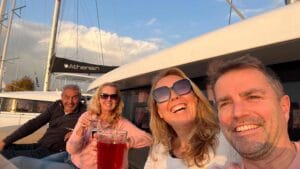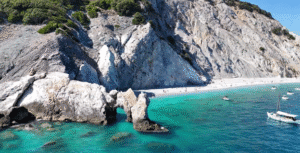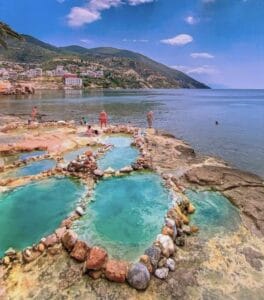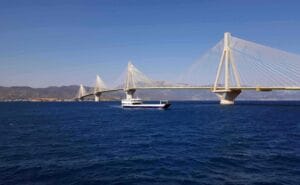When I was researching which places might be interesting to visit on or around the Gulf of Corinth, I suddenly saw the word “Delphi” on the map on the northern side of the Gulf. I thought: what! The Oracle of Delphi?
And yes indeed, this was the world-famous ancient city to which generals and kings travelled—from Greece, but also from Italy, Egypt, and even Turkey—to ask the Oracle a question.
We simply had to see it!
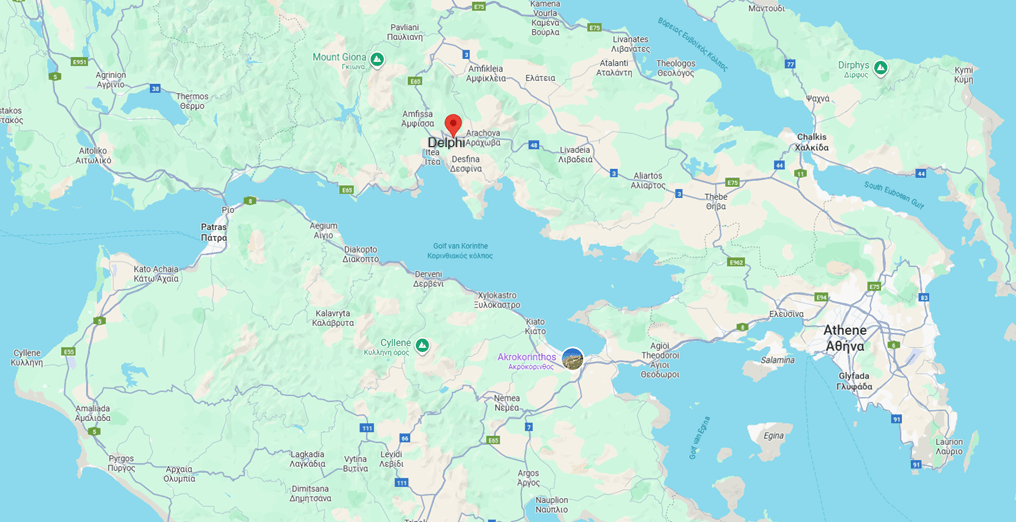
After our visit to Galaxidi, we sailed farther north to the harbour of Itea, since from there you can travel to Delphi.
Our start was slightly less glamorous: here you see the harbour with the electricity box, which looked more like it was about to collapse than provide power to our boat 😉. But amazingly, it worked. And that was important for us, because outside the high season, on shorter days, it’s nice to have some extra electricity available.

I had looked into how to get to Delphi, because it lies deep inland and high in steep mountains. It is also a large complex spanning about 2 km with multiple temples.
The solution was the bus from Itea, and asking whether we could bring our e-bike and e-step, so that once there we could cycle back downhill. It took some puzzling (the buses only run twice a day in this season) and especially figuring out where the bus stop actually was (a tiny sign), but it worked. We could take the bus at 10:00, and the e-bike and e-step could go in the luggage compartment of the coach.
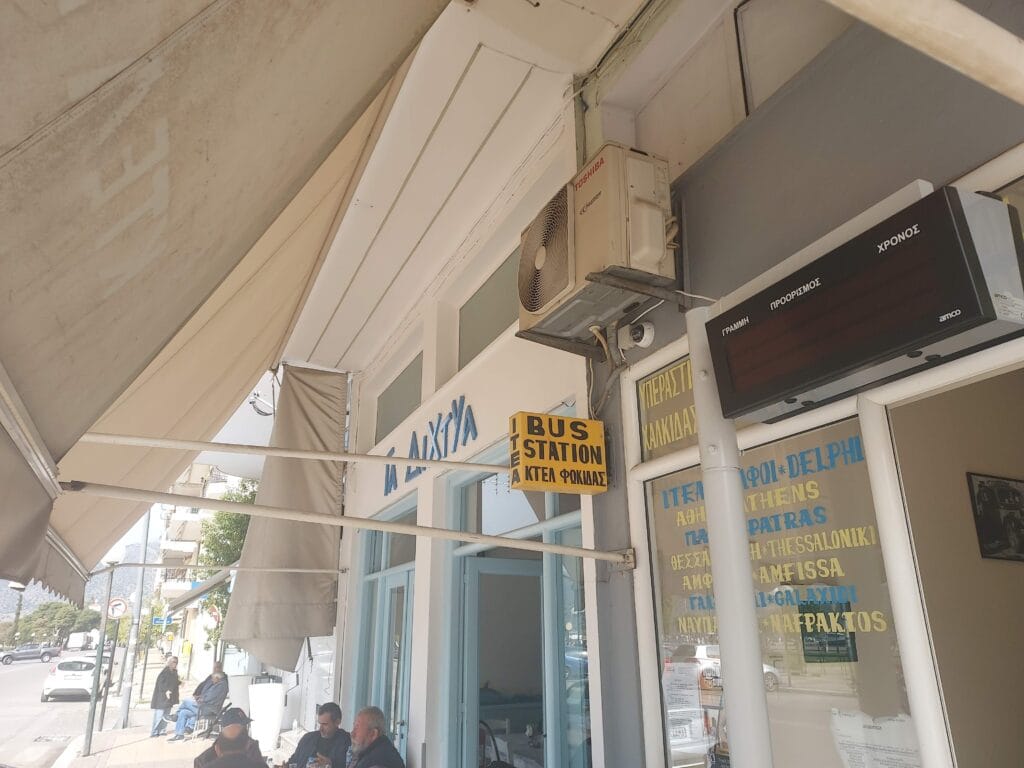
It was a very nice 40-minute ride, with hairpin bends, small mountain villages and beautiful views along the way. From a plateau you could look straight into the valley and over the Gulf of Corinth. That alone made it worthwhile 😉.

We were surprised when we got off the bus in modern Delphi and cycled to the complex: it was extremely busy! Everywhere has been getting quieter lately, but apparently this hotspot attracts many tourists and entire school classes.
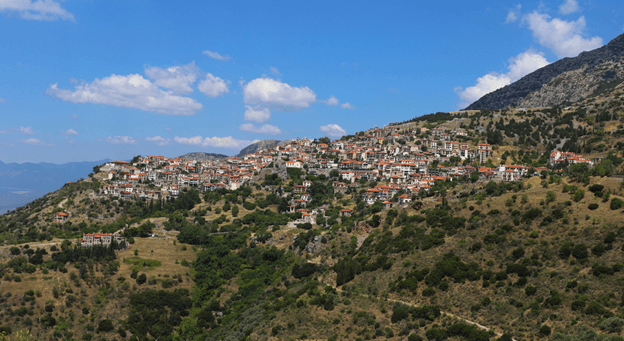


We bought a ticket for the whole complex and decided to visit the museum first so we could read up on the history.
Delphi Museum
The museum is full of treasures and riches gifted to the Oracle. There is plenty of information about the site and the Oracle itself.
The best-known item is the Naxian Sphinx, an impressive ancient Greek monument donated to the sanctuary of Delphi by the inhabitants of Naxos, one of the Cycladic islands (east of the Gulf of Corinth). The statue dates from around 560 BC.
The sphinx is a mythological figure with the body of a lion, the wings of an eagle and the head of a woman. This type of sphinx originally comes from ancient Egypt and was later adopted by Greek culture, but in a more slender and elegant style.
The statue itself is 2.2 metres high, but originally stood outdoors on a tall Ionic column of 10 metres. This made the sphinx look down on visitors to the oracle of Delphi in a threatening way, giving a sense of mystery and holiness.
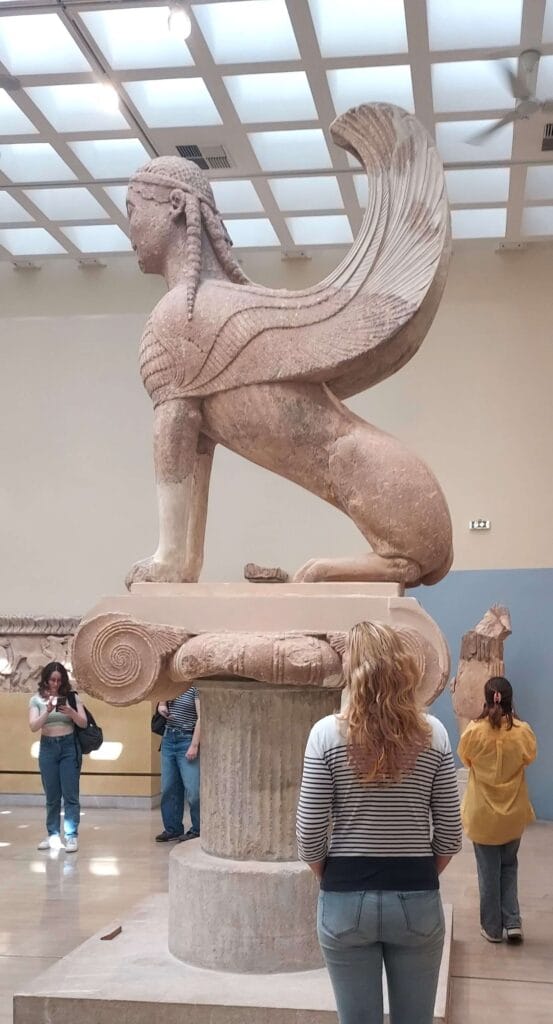
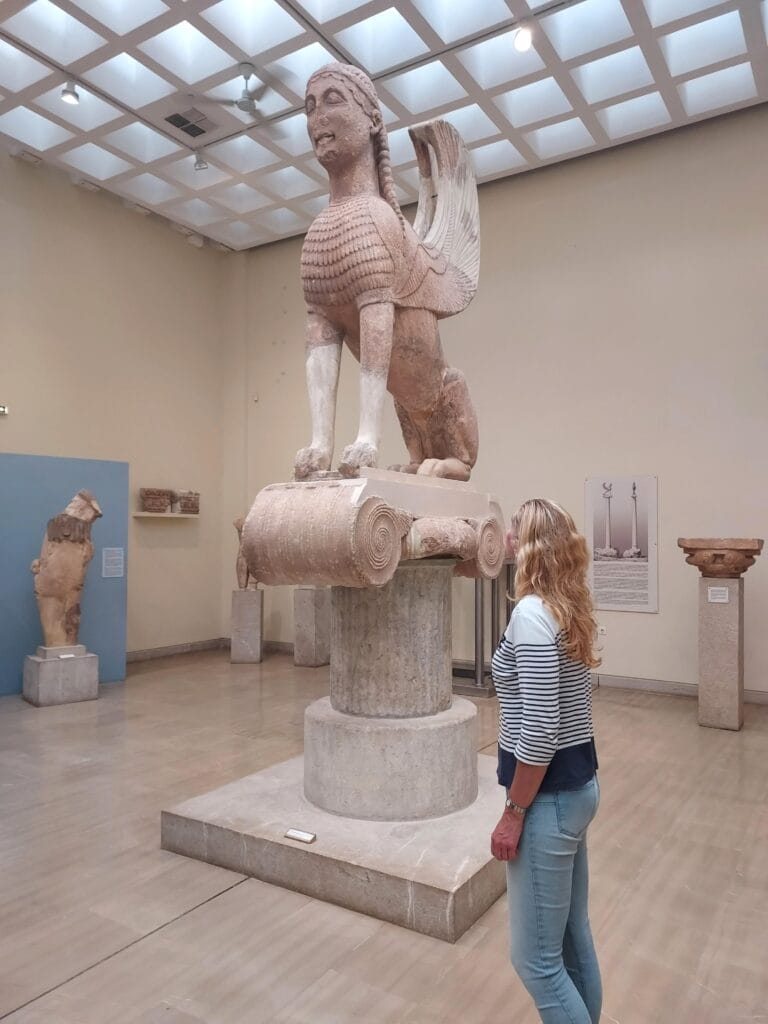
The Navel of the World
Delphi is located on the southern slopes of Mount Parnassus in Central Greece. It overlooks the spectacular valley we arrived through. According to the Greeks, this was the centre of the world, the so-called “Navel of the World” (Omphalos).
I could understand why this place was chosen for the Oracle. Its special mountainous location enhanced its spiritual character: visitors had to make a demanding journey before they could consult the oracle.
The ruins lie like terraces against the mountainside, with various complexes spread out along about 2 km.

There is a theatre—beautifully situated high up—seating 5,000 spectators and offering phenomenal views of the valley.
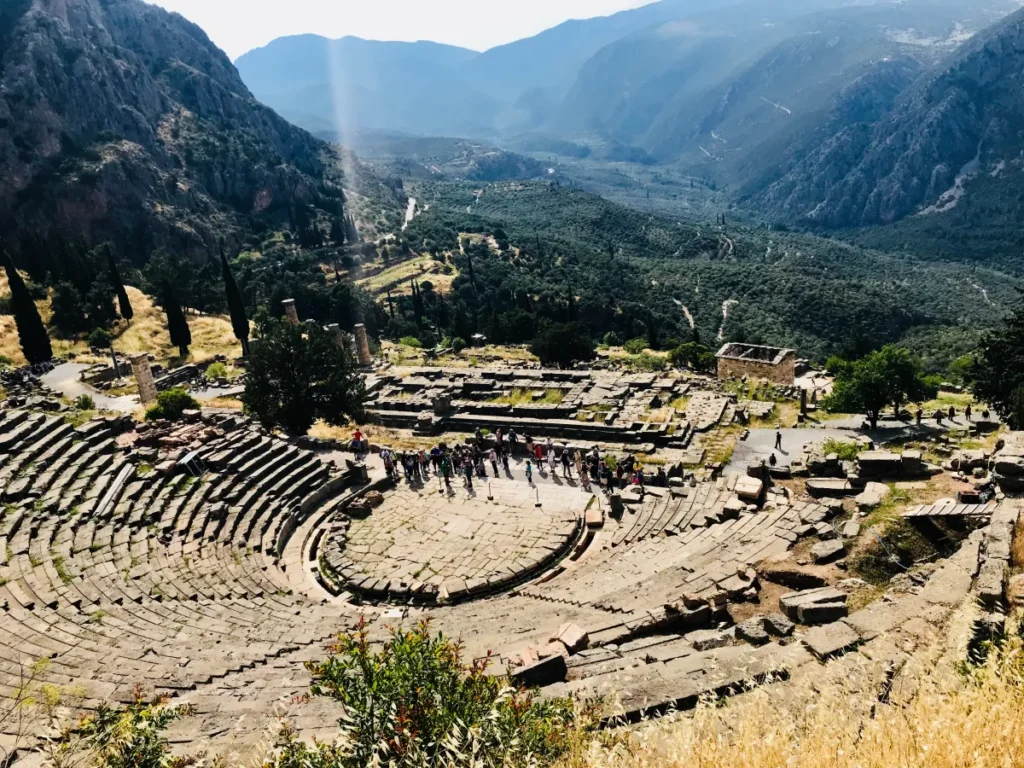
Even higher is the Stadium, where every four years the Pythian Games were held. These athletic events were the most important in Greece after the Olympic Games.
The Tholos of Athena Pronaia is an iconic round building with remaining columns, located farther out and one of the most photographed places in Delphi.
We flew our drone over the complex—here you can clearly see how large it is:
How the Oracle of Delphi worked
The most famous part of Delphi is the Oracle of Apollo. Visitors from all over Greece (and later the Mediterranean world) came here for advice—from personal matters to state affairs. This is how the Temple of Apollo looks like now:
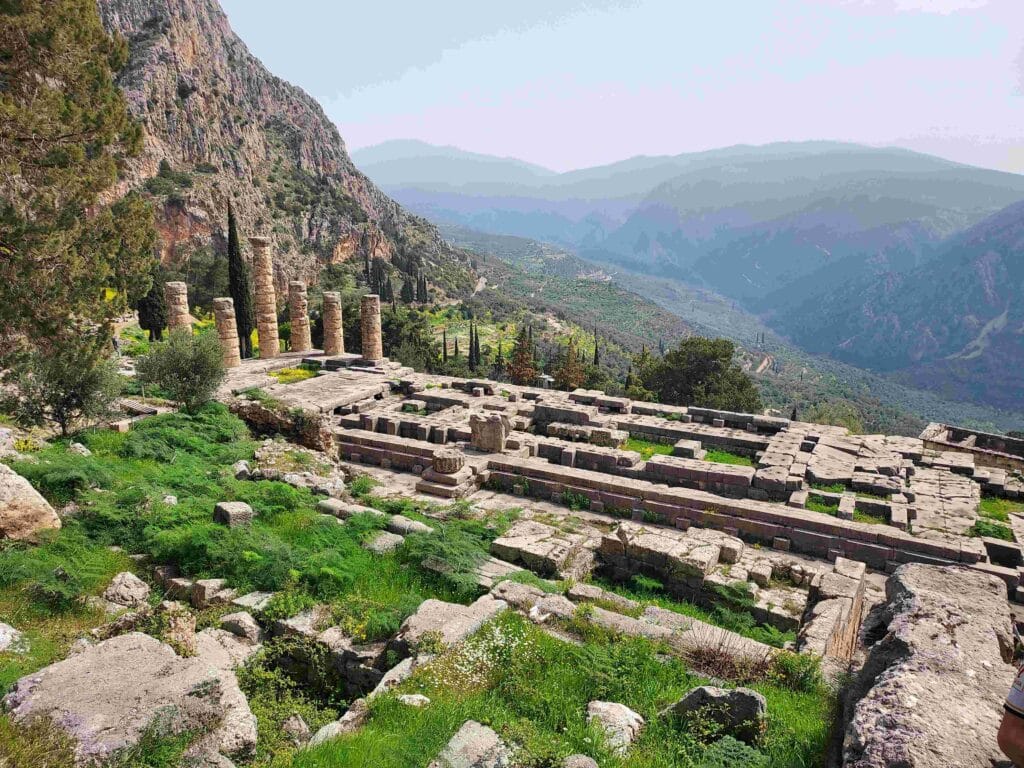
The oracle was only accessible on one day per month (the seventh day), except in winter when Apollo was believed to be “absent.” The prophecies were spoken by the Pythia, a priestess of Apollo. Priests transformed her words into verse.
The oracle was active for about 1,000 years (8th century BC – 4th century AD).
The questioner (an individual, city-state, or king) travelled to Delphi, often via the Sacred Way up to the sanctuary of Apollo. This journey was considered a pilgrimage.
Along the Sacred Way stood monuments and treasuries dedicated by cities offering gifts to Delphi. The most famous is the Treasury of the Athenians, one of the best-preserved structures near the oracle, built after their victory over the Persians.
The Athenians consulted the oracle during the war against the Persians (480 BC). The oracle said:
“The wooden wall will protect you.”
Some Athenians believed this meant the city walls, but Themistocles interpreted it as the fleet of wooden ships—leading to the famous naval Battle of Salamis, where the Athenians defeated the Persians.
Upon arrival in Delphi, the questioner and companions took part in ritual purification: bathing in the Castalian spring to cleanse impurities. The priest or Pythia might also prepare by withdrawing from daily affairs and focusing on spiritual purity.
Before posing a question, an animal—usually a goat, sheep, or bull—was sacrificed on the altar of Apollo. The animal was sprinkled with cold water: if it trembled, this was a favourable sign and the question could proceed. If not, Apollo was believed unwilling to answer.
The question was submitted to the priests. Some states had priority (promanteia) due to donations or status. Questions had to be clear and specific, as interpretation was important.
The prophecy was delivered by the Pythia, who sat on a tripod above a crack in the earth. She chewed laurel leaves (Apollo’s sacred symbol) and drank holy water to enter a trance. According to tradition, vapours rose from the earth, bringing her into ecstasy.
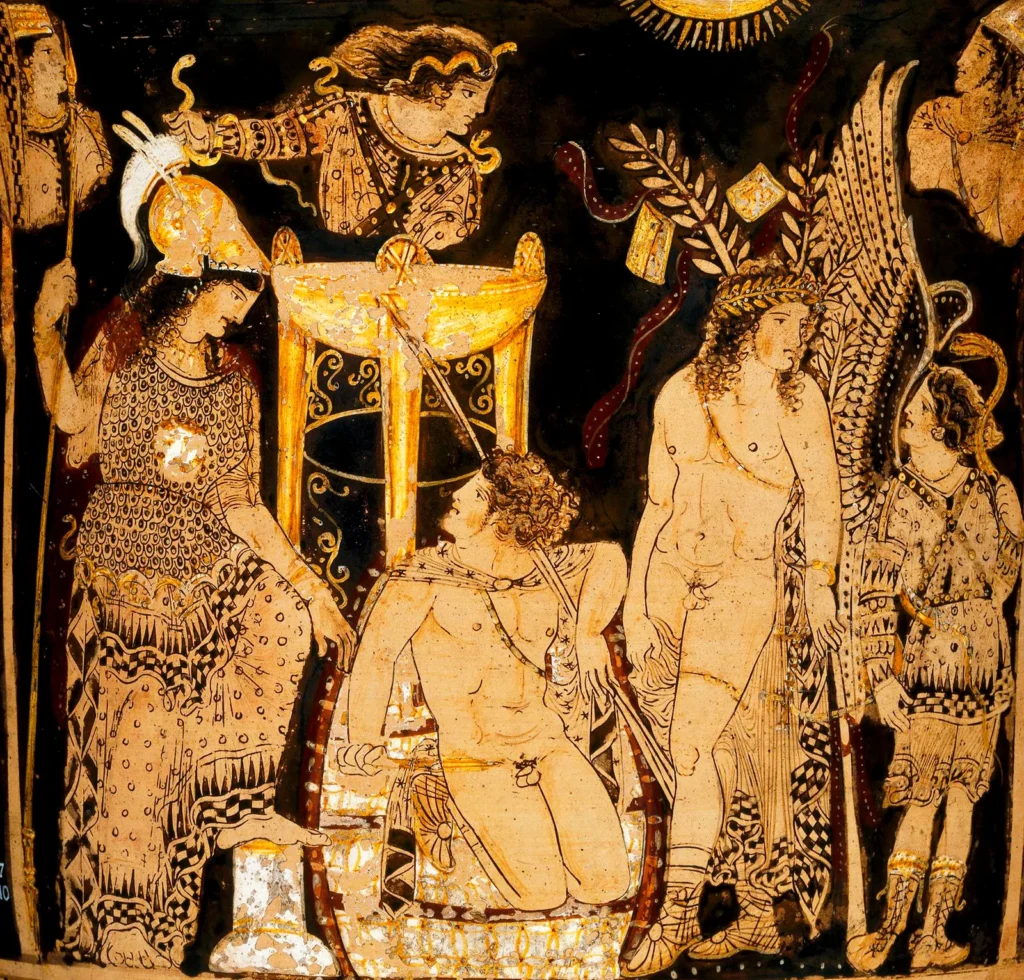
In her trance, the Pythia uttered sounds, words, cries or sentences—often vague and ambiguous. Priests interpreted her speech and formulated it poetically or in enigmatic verses.
The questioner received the prophecy and had to interpret its meaning. Responses were often open to multiple interpretations. About 615 prophecies have been saved in literary sources. They were made in answer to various questions of military, religious, state-related or personal questions such as forming a family, winning at the games,
After the prophecy, offerings of thanks were made. The questioner returned home—sometimes with news that changed everything.
Examples of Oracle prophecies
Croesus, wealthy king of Lydia, wanted to know whether he should wage war against Persia. The oracle answered:
“If you make war on the Persians, you will destroy a great empire.”
Croesus assumed this meant Persia—but he was defeated, losing his own empire.
Another example: Solon, Athenian statesman, asked how to reform Athens. He was told:
“Position yourself now amid ships, for you are the pilot of Athens. Take the helm… you have many allies.”
Solon decided not to become a tyrant but to share power and give citizens more rights. He introduced reforms—debt cancellation, legal access for the poor, and more citizen rights. These reforms are seen as a foundational step toward Athenian democracy.
Delphi was viewed as the centre of the world, where divine wisdom could be accessed. Since prophecies were ambiguous, the oracle was never truly “wrong.” Its reputation grew, and cities and leaders brought enormous treasures to Delphi, hoping for favourable predictions.
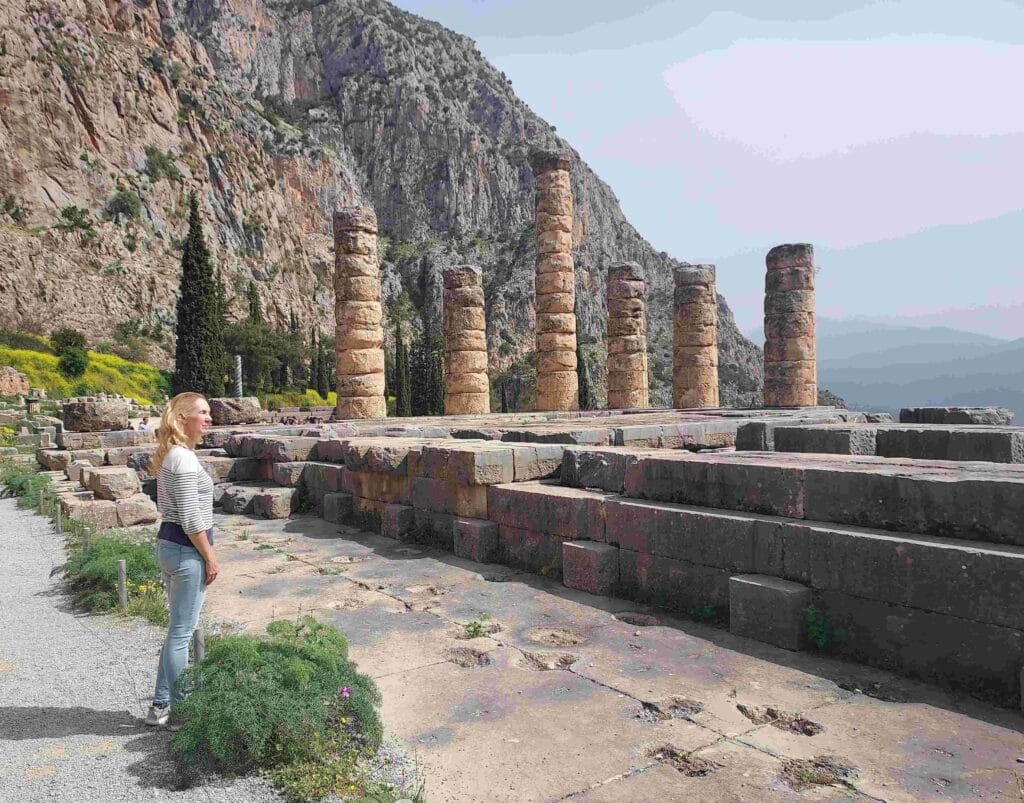
The end of the Oracle
Its influence declined under Roman rule and ultimately ended when Christianity became dominant. The last Pythia spoke in the 4th century AD; afterwards, Emperor Theodosius I closed pagan temples. Delphi fell into ruin and was eventually abandoned.
We flew our drone one last time over the impressive complex of Delphi and at 42 seconds in this video you can see us cycling back in the steep mountains and deep vallies, along the hairpin bends to the coast!

